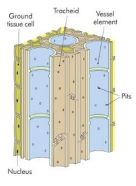Chapter 23: Structure of The Flowering Plant
The Root System
Functions:
Anchor the plant in the ground
Absorb water and minerals
Transport absorbed materials to shoot
Storage of food
Types of Root:
Tap Root
One main long root that comes from the radicle (young root) of the seed, lateral/secondary roots emerge from this and usualy have root hairs.
Present in dicots
e.g. dandelion, carrotFibrous Root
Formed when the radicle dies and leaves equal sized roots coming out of the stem
Present in monocots
e.g. daffodil, grassAdventitious Root
These do not grow from the radicle, are found in odd places.
Fibrous roots and gripping roots are in this category.
e.g. ivy, strawberry plant
Root Zones:

Zone of Protection
Root cap protects the meristem as it pushes through soil.Meristematic Zone
Contains cells that divide by mitosis. Apical meristems found at root and shoot tips.
Lateral meristems at side of plants (side branching)..Zone of Elongation
Newly formed cells absorb water and plant growth regulators (Auxin) stimulate cells to grow longer.Zone of Differentiation
Elongated cells are undifferentiated. They develop into:
- Dermal Tissue
- Vascular Tissue
- Ground Tissue (between dermal and vascular)
The Shoot System

Functions:
Support aerial parts of the plants
Transport water and minerals from the roots to the leaves and flowers
Transport food made in the leaves to the roots
They carry out photosynthesis when they are green
They may store food
The Leaves
Also known as lamina
Functions:
Photosynthesis
Gas Exchange
Transpiration (water loss)
Food storage (grasses, lettuce, cabbage)
Some leaves are attached to stem via a petiole.
Others are joined directly (sessile).
Parallel Venetion
Veins run parallel to eachother
MonocotNet Venetion (reticulate)
Veins are branched
Dicot
Plant Tissue
Meristematic Tissue
Small simple cells with no vacuoles
Function: Mitosis (new cells for growth)
Apical meristems are located at tip (apex) of root and shoot
Also found at buds (areas of growth)
Dermal Tissue
Similar to skin on humans
Primary Function: Protective cover on stem, leaves and root. Stops entry of pathogenic organisms.
Secondary Function: Epidermal cells at root tips designed to absorb water and minerals.
Epidermis in stem and leaves have a waxy cuticle to prevently water loss.
Ground Tissue
Forms the bulk of plants. Fills the interior of the plant body.
Function: Photosynthesis, food storage and provides strength to the plant.
Vascular Tissue
Function: Transport substances within the plant
Has two types, xylem and phloem
Xylem

Function: Transports water and mineral salts from the roots to the leaves, mechanical support
Located in roots, stem, leaves and flowers
Consists of two kinds of conducting cells, xylem tracheids and xylem vessels.
Both tracheids and vessels die before maturity. Thus, xylem tissue is said to be dead.
- Xylem Tracheids

Long cells tapered at both ends
Contains pits (allow water and minerals to move sideways from cell to cell)
Only found in conifers
- Xylem Vessels

Form when numerous cells join end-to-end.
Wider than xylem tracheids and stacked together.
Have no end walls forming a continuous conducting tube
Contains pits
Both vessels and tracheid contains lignin (structural polysaccharide)
Phloem

Function: Transportation of food made in leaves, companion cells controls sieve tube element
Located in vascular bundles in roots, stems, leaves, and flowers.
Consists of phloem sieve tube elements and companion cells
Are elongated cylindrical cells stacked end-to-end
End walls have holes called sieve plates (this allows cytoplasm to pass from cell to cell)
When mature, the nucleus degenerates - the cytoplasm remains
Each sieve element has a companion cell (connected by cytoplasmic connections)
Monocotyledon
One cotyledon
Vascular bundles are scattered
Parallel veins
Flowers have petals in multiples of 3
Dicotyledon
Two cotyledons
Vascular bundles in ring shape
Dendritic veins (net veins)
Flowers have petals in multiples of 4/5
Tropisms
Growth response of a plant to stimulus
Plants respond to stimuli by changing their growth
Phototropism
Growth of a plant in response to light, so that it can receive the maximum amount of light for photosynthesis.
Geotropism
Growth in response to gravity, it allows the root to get the water and nutrients it needs from the soil, and raises the leaves up into the light for photosynthesis.
Thigmotropism
Growth of a plant in response to contact, gives support to the plant.
Hydrotropism
Growth of a plant in response to water, they will grow towards a water source.
Chemotropism
Growth of a plant in response to chemicals.
Plant Growth Regulators
Plant growth regulators (hormones) are chemicals that interact with one another to control a particular development or response.
Plants only grow at their tips in small regions of active cell division called meristems - the tips of shoots, roots, and side buds.
Plant growth regulators are produced in the meristems and transported through the vascular system (xylem and phloem) of the plant.
Active in very small amounts.
Their effects depend on concentration.
A small amount of growth regulator can have a great effect on growth.
Promote growth:
Auxins, Gibberellins, Cytokinins
Inhibit Growth:
Abscisic acid, Ethene
Auxin
Promote cell enlargement and growth.
Are involved in phototropism and apical dominance.
In shoots, light causes auxin to move down the shaded parts of the stem, causing the shoot to grow towards the sunlight.
Can be used to kill weeds and stimulate root formation.
Gibberellin
Causes stem lengething.
Mobilise the stored food in germinating seeds.
Break dormancy in buds and seeds in spring.
Cytokinins
Stimulate cell division and trigger leaf growth in spring.
Abscisic Acid
Triggers bud and seed dormancy in autumn and inhibits cell growth.
Ethene
Promotes ripening of fruit and the fall of leaves, flowers and fruits.
Structure of the Flower

 Knowt
Knowt